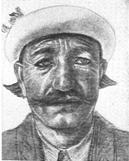|
(Photographic Supplement, Plate 15)
The Alpine race is as important in the mountain zone from Syria to the Pamirs as it is in the corresponding portion of Europe. Both anthropometrically and morphologically, the European and Asiatic Alpines are essentially identical. Furthermore, when not too strongly altered by mixture with other stocks, the Asiatic Alpines tend to an intermediate pigment condition comparable to that of their European counterparts. FIG. 1 (3 views). A Syrian Alpine from Damascus. This man is typically Alpine, except perhaps for his rather extreme face length.
FIG. 2 (3 views). A Druze from Shuf, southern Syria. This man is in all respects an excellent Alpine. The Druze, followers of a secret religion based on the schismatic teachings of the Khalifa Hakim of the Mediaeval Fatimid Dynasty, claim to be descended from immigrants who moved from Yemen to Syria in the sixth century A.D. Although this tradition may be accurate, nevertheless the majority of the Druzes today are brachycephalic, and show a predominance of Alpine facial characters, which could only have had a local origin.
FIG. 3 (3 views). An Armenian from Cilicia, Asia Minor. The Armenians, for the most part Dinaricized, include in their ranks a minority of individuals who represent, as does this man, the Alpine prototype of the Asia Minor brachycephals.
FIG. 4 (1 view, photo B. N. Vishnevsky). An Iranian speaker from Russian Turkestan; a good example of a central Asiatic Alpine.
FIG. 5 (1 view, photo B. N. Vishnevsky). A Mountain Tajik from the Pamirs. The Tajiks are basically Alpine, and resemble the south-central French closely in an anthropometric sense. They form the last major outpost of the Alpine race to the East, as far as we know at present.
FIG. 6 (1 view, from a tempera painting by the artist Iacovleff, from his album Peintures d'Asie, Paris, 1935, permission Mme. Iacovleff). An Alpine-looking Hunza from the Hunza valley above Gilgit, in the Himalayas. The western Himalayas, from Kafiristan over into Tibet, are proving to be a refuge area of the greatest importance, with interesting racial as well as cultural implications. Nordics, various varieties of Mediterraneans, as well as Alpines and other strains are apparently preserved in the inaccessible valleys of this territory.
|





